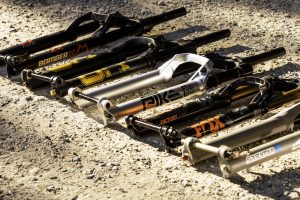Is 650b the new magic number?
What’s it all about?
650b is not a new planet, or the bus route between Gidea Park and Romford, but the latest wheel size to be adopted by the mountain bike market. First came the 29er, now 650b is hitting the headlines.
650b might seem like the new kid on the block, but it’s actually been around for many years. It’s an old French size, with its roots in touring bikes and small-framed road bikes, that’s been pulled out of the attic, dusted off and given a fresh lick of paint by the spin doctors.
Getting your head around 650b is not as simple as the marketing men would have you believe. Most spin concentrates on placing it halfway between 26in and 29in in terms of size and qualities, hence the 27.5in conversion promoted by many American brands. In fact, as we’re about to explain, it’s a lot closer to 26in.
A 26in wheel (with a 2in tyre mounted) has a diameter of 26in (660mm). But this is a dimension that can very according to the size of the tyre mounted, so for greater accuracy the International Organization for Standardisation (ISO) devised the Bead Seat Diameter (BSD) measurement. This disregards the tyre and concentrates on the rim, taking a diameter between the bead seats of the rim (the part that the tyre hooks onto).
So, for a 26in wheel, the BSD is 559mm (22 and a bit inches), for 650b it’s 584mm (just under 23 inches) and 29in wheels are actually 622mm (24.5in give or take a hair’s breadth). With that same 2in tyre mounted the complete wheel package sizes become 26in, just under 27in for 650b and 28.5in for, er, 29ers. So much for industry clarity.
What we learn from all this number crunching is that choosing the right wheel size is about as easy as picking the lottery numbers, and if the bike industry can’t do the maths, why should we trust anything else they say about them?
Why is it for you?
It’s fair to say big wheels are here to stay. Like them or not, the benefits are real, even if they don’t work for all riders in every situation. With 650b, or 27in as we might start calling them, you get all the perks of a larger diameter with none of the tax implications. At least that’s the thrust of all the marketing spiel. In terms of benefits, we’re talking extra traction, improved rollover and momentum. The flipside of this is extra weight, stiffness issues, sluggish acceleration and geometry problems.
For Owen Pemberton, from Norco bikes, 650b’s lack of shortcomings are its greatest asset; “when compared to a 26in wheel, 650B offers all of the same advantages as a 29er, just not to the same extent. Where it gets really exciting, for me anyway, is that you can achieve the same geometry as a 26in bike”.
Scott is another big brand to get behind the mid-size wheel option. We asked its US Marketing Director, Adrian Montgomery, what made Scott take the plunge? “When designing a bike with over 130mm of travel the 29in wheel is just too big. The bottom bracket offset is wrong, the headtube height is too high and ultimately the geometry and fit challenges begin to outweigh the benefits. If you introduce the 650b wheel into the equation you can make a longer travel bike without these challenges at only 4% more system weight for the wheels than 26in, and you get improved momentum, traction and rollover ability. The 29in wheel system, in comparison, is 11% heavier than 26in. There are no downsides to adopting the 650b standard for the customer, only upsides.”
Who’s behind it?
Although Jamis single-handedly championed 650b for many years, the big brands to recently get on board are Scott, Norco, Rocky Mountain, Cube, Ghost, KHS, Intense, KTM and Saracen. Sounds like a pretty heavily laden bandwagon, but each of these brands only offers, at most, a few models across one or two platforms. Certainly, none of them has completely abandoned 26. Even early adopter, Jamis, still offers all three wheels sizes in its range. So, while the marketing machine is firing on all cylinders, it seems to be making a lot of noise without really going anywhere… yet. Since this article was published in December 2012 we’ve seen and heard of many new bikes and products that will use the new size. 650b seems to be gathering momentum very quickly.
How does it ride?
In a nutshell, like a 26in wheel. We rode three 650b bikes on similar terrain during a two-week period in Whistler. None of them felt like they gave appreciable benefits in terms of traction or rollover. On a 29er you can feel the difference; with a 650b it’s much more subtle. However, this similarity with 26in wheels can also be seen as an asset; you can jump straight on a 650b bike and feel right at home. There’s none of the frustrating crossover period associated with 29ers and no need to adapt your technique or work round its various foibles.
Having said all that, we haven’t, as yet, had the chance to test a 26in wheel bike against a 650b bike back-to-back on the same trail. That’s something Adrian Montgomery believes will bring the advantages into sharp focus; “the biggest difference is felt when you go back to a 26″ after riding 650b on the same trail. You can feel your rear wheel hanging up on square edge bumps and your tyres are way sketchier at the same speed you were confident on the bigger wheels. Once you try it, you can never go back.”
Owen Pemberton has a similar outlook; “one of my favourite quotes from one of our test riders after first riding the Sight 650B prototype is “it just feels like a bike… only faster”, this sums it up perfectly for me”.
Is it here to stay?
Let’s face it, 650b is not reinventing the wheel, but the very fact that it occupies a safe middle ground will almost certainly see it take over in the next few years. Provided fork, rim and tyre manufacturers get on board, as has been promised, 2014 could see 650b filling all the niches still clinging onto 26in.

















